Every day, combat missile crews, security forces, maintainers, and support personnel of USAF’s 90th Missile Wing at F. E. Warren AFB, Wyo., fan out over 9,600 square miles of missile fields. The wing is responsible for 150 Minuteman IIIs—a third of the Air Force’s deployed ICBM force—housed in silos on the plains of Colorado, Nebraska, and Wyoming.
Working in hardened launch control centers buried some 60 feet underground, missile crews stand constant alert, ready to launch their nuclear weapons immediately upon presidential order.
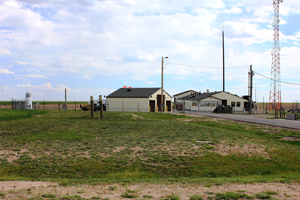
| ||
|
Missile Alert Facility Echo-01 is assigned to F. E. Warren AFB, Wyo. The base’s missile fields house one-third of USAF’s deployed ICBMs. (Staff photo by Aaron M. U. Church) |
F. E. Warren recently shifted its multiple-warhead ICBMs to single-warhead configuration. However, this changeover barely affected its day-to-day business of keeping the US land-based deterrent reliable, credible, and ready.
Located on the outskirts of Cheyenne, Wyo., Warren accommodates one of USAF’s three ICBM wings. The other two are at Minot AFB, N.D., and Malmstrom AFB, Mont. These wings are the only Air Force units on wartime alert at all times. For the men and women of the 90th Missile Wing, assuring the constant security and readiness of a major part of the nation’s nuclear deterrent arsenal is a significant achievement.
The size of the 90th’s area of responsibility, nearly as large as Vermont, poses major challenges for the operational, support, and security forces. “That’s what we have to worry about every single day,” explained Col. George R. Farfour, 90th Missile Wing vice commander.
Every 24 hours, a new shift of missileers, facility staff, and security forces set out. They traverse interstate highways and dirt and gravel roads, no matter the weather—howling winds, rain, and even snow—to relieve other crews. “We drive about 7.5 million miles in a year because everything is ‘out,’ ” said Farfour.
Through All Kinds of Weather
Farfour likened the vast F. E. Warren missile complex to an archipelago of “166 [separate] Air Force bases.” He referred to the fact that the complex comprises 150 missile silos and 15 launch control centers, as well as F. E. Warren itself—all of them geographically separate bits of operational real estate.
A two-man missile combat crew in an underground capsule runs each LCC. Above the capsule, at the surface, is a supporting missile alert facility. Security forces, a short-order cook, and a facility manager continually staff the MAF.
In all but the most menacing weather, members of an LCC/MAF drive to the assigned alert site. There are, however, other means available. The wing’s UH-1N helicopters—usually held for security response needs—can shuttle crews when heavy rains turn the roads into seas of mud or icing and snow drifts make them impassable.
On a good-weather day, it takes crew members two hours by land vehicle to reach the most remote site, said Lt. Col. Matthew Dillow, commander of F. E. Warren’s 321st Missile Squadron. In the normally harsh High Plains winter, it can take considerably longer.
When necessary, an alert crew can be held over at a site for 48 hours. This happened only twice in the last year, in part because the winter was mild, Farfour said.
Each alert cycle begins with a wing-wide mass brief, introduced by Col. Christopher A. Coffelt, the wing commander. On a typical day in May, 1st Lt. Jeremy Stober, a missile combat crew commander with the 321st Missile Squadron, and 2nd Lt. Christopher Bridges, his deputy, are assigned to Missile Alert Facility Lima-01.
At the surface facility, the alert crew, including the facility manager and the cook, process through security. It is a precisely scripted ritual, requiring each person entering to affirm that he or she is under no duress from an outside force.
Once inside the gate, they proceed to the MAF, essentially a mini-base, with its own electrical generators, water supply, kitchen, beds, and security station. Inside the MAF, the two missile crew members halt at the top of an elevator shaft. At the bottom is a launch capsule. Stober and Bridges repeat the security routine before entering the secure station at the head of the elevator shaft.
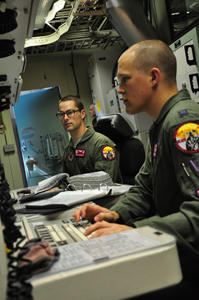
| ||
|
First Lt. Paul Comaroto (l) and Capt. Paul Hendrickson train in a Minuteman III launch control simulator. (USAF photo) |
Up to this point, they come under the Air Force Global Strike Command’s chain for organizational and training purposes. Once they descend to the capsule, the two lieutenants officially report directly to the head of US Strategic Command, USAF Gen. C. Robert Kehler, who has a direct line to the President.
During the ride on the elevator down to the LCC capsule, Stober and Bridges each remove the AFGSC patch from a Velcro spot on their flight suits and replace it with a USSTRATCOM patch, symbolically marking the transition of authority.
“They have a unique mission here in the continental United States in that they are supporting combatant command operations day-to-day,” said Dillow.
Fail Safes
Dillow noted that the Minuteman III is the only Air Force weapon permanently kept on full-up war footing. Indeed, even AFGSC’s nuclear-armed B-2 and B-52 bombers “are not on alert on a day-to-day basis. They can generate to that state, but [only] the ICBMs are ready to do what needs to be done.”
At the bottom of the shaft the crew pass through a massive, vault-type doorway into the capsule. To their left lies an engineering plant providing everything needed for self-sufficient operations. In the event of an overhead nuclear detonation, the plant can purge the capsule’s air of toxic particles, supply water to the crew, and generate electrical power. These actions could allow the crew to survive and, if ordered to do so, launch a retaliatory strike.
Stober and Bridges turn to their right through another blast door to enter the control center, where they swap notes with the departing crew. They learn that the preceding 24 hours at Lima-01 had been unusually eventful. A mechanical problem forced the capsule to switch over to its own generator, a diesel unit used to power everything inside.
India-01, one of the squadron’s four other LCCs, also lost commercial power overnight. India-01 switched to generator power, but when the power grid resumed operations, the site had failed to switch back. This forced a temporary shutdown of the site to resolve the problem.
“Everything’s running fine [at Lima], so no shut-down issue like [at] India,” says Stober.
Normally, each LCC is responsible for 10 ICBMs. In cases like that of India-01, any of Warren’s 14 other control centers can instantly take control of India’s missiles, ensuring full control. Even if all 15 LCCs were to fail simultaneously, an E-4B airborne command post aircraft can still control missiles from overhead, providing an additional layer of certainty.
Today, Stober and Bridges are engaged in an annual “code change” of missile hardware. The secret codes needed for the activation of each of the 150 missiles are changed every year as a security precaution. The 321st MS personnel must physically change codes at five LCCs and at 50 Minuteman III launch facilities.
The changeover makes the operations tempo unusually hectic. “We can only do about 10 [code changes] in a day because it involves a team actually going down to the missile,” said Dillow. “It’s pretty involved.”
He explained that for each missile, there are two sets of codes to be changed out, one at the LCC and another at the ICBM. Each of the wing’s 150 ICBMs are miles away from the LCC, and the whole process takes a week of cooperation from maintenance teams, missile crews, and security forces.
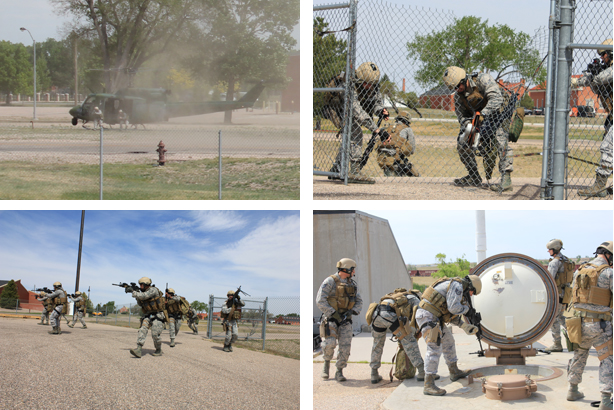
| ||
|
In the series of images below, a Tactical Response Force team from the 90th Security Forces Group responds to a simulated takeover of a missile silo. |
Once the new missile crew is on alert, Stober and Bridges are the only two people in the LCC, responsible for 10 nuclear-tipped Minuteman IIIs for the next 24 hours.
The Minuteman III originally contained three nuclear warheads, making it a so-called “MIRV” system; the term MIRV stands for multiple independently targetable reentry vehicles. The 90th Missile Wing’s MIRVed missiles were the first to drop to single warhead status.
Minuteman weapons at Minot and Malmstrom are still MIRVed, though they, too, will soon shift over to the single-nuclear-charge configuration.
Boredom is not on the agenda in the capsule. Up and down the chain of command, USSTRATCOM remains in a state of constant exercise—passing coded messages, verifying command procedures, and keeping strong each link, from the President down to the individual LCCs, ready for war at an instant’s notice.
The crews receive coded messages that they have to interpret, validate, and respond correctly to. The crew also has responsibility for troubleshooting the weapon system itself—no small task, considering the complexity of nuclear command and control.
On the rack above the command console is a library of manuals and technical orders covering all aspects of the weapon system, from the capsule where the crew sits to the actual missiles themselves.
“If you have a whole bunch of maintenance or if something is going wrong, that … can be very stressful if you’re trying to figure it out” under strict time limits, Stober observes.
During any downtime, Stober instructs Bridges on weapons protocol and systems, studies for monthly exams, or works on a master’s degree. However, with an ongoing code-change and maintenance problem, there is little free time on the day’s schedule.
Pretty Near Perfect
On slower alerts, either Stober or Bridges can rest in the bunk at the end of the capsule, as long as one remains at the console.
“If anything significant is going on down there, they have to be awake, and I’ll tell you, more often than not, there’s something significant going on out there,” asserted Dillow. “The tempo can be pretty brutal, frankly, and it’s not something that’s well understood across the Air Force.”
The rigorous and constant evaluation that missileers undergo is testament to the gravity and unforgiving nature of the nuclear mission. Since AFGSC took over and revitalized the nuclear force in 2009, the scrutiny has intensified.
“The need for those exacting high standards—that critical culture of self-assessment where we constantly have to be our own worst critics, … those things that were the hallmark of Strategic Air Command—had started to erode culturally,” Dillow observed. “This is a very important mission area that requires a certain amount of focused attention and I think we get that from Global Strike Command and that’s the difference now.”
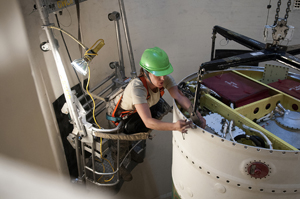
| ||
|
SrA. Jessica Kulla, 90th Missile Maintenance Squadron, detaches a sling that lowered a post boost control system onto a Minuteman III. (USAF photo by R. J. Oriez) |
Every month, missileers must post near-perfect passing scores on three exams: on launch orders and validation protocol, technical weapon-system knowledge, and launch codes.
“People are watching everything that you do—scrutinizing,” says Stober. He adds that, if a missileer fails to score 90 percent or higher on certain aspects of the job, “you get restricted on your certification.”
Missile combat crews are evaluated every month on their practical skills in a launch control center simulator as well. Between alerts, the crews practice in the simulator, and occasionally “they’ll throw in extra testing,” especially in anticipation of a code change, notes Stober.
On top of this, AFGSC mandates that each missileer pass a no-notice operational evaluation annually. In practice, the surprise evaluations take place more frequently, especially since the Air Force stood up Global Strike Command. Some crewmen in the 321st were evaluated three or four times in the last year, according to Stober. He called it “a fairly new thing.”
The missile combat crew may be alone in the capsule, but they are far from alone on alert. In addition to the fixed contingent of security and support personnel topside, the wing’s specialized air-mobile rapid assault team—the Tactical Response Force—went on 24-hour alert starting late last year.
“This team is designed as a nuclear capture-recovery team; that is their prime directive,” said SMSgt. Jared Skinner, 90th Security Forces Group TRF superintendent.
Armed members are frequently seen in the open side doors of the Huey helicopters flying low over the missile field. This is a daily “show of presence” mission. Unlike in-field security forces posted at the MAFs or guarding the maintenance teams at the launch facilities, the TRF is constantly in motion, adding an element of unpredictability to foil potential intruders.
“You don’t always know where it is, where it’s coming from,” said Skinner. When sensitive components move on the road, the TRF flies as an “airborne fire team support” providing reconnaissance and top cover to the convoy, explained Skinner.
Defeating an attack is, however, the TRF’s main calling and the entire reason for round-the-clock alert. During maintenance operations such as code changes, the launch facilities are at their most vulnerable, with crews working on the ICBMs in their silos.
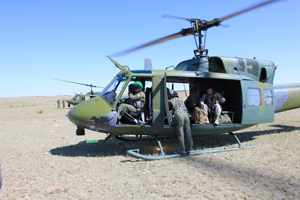
| ||
|
A crew from the 37th Helicopter Squadron on a mission at Warren. The 37th coordinates closely with the 90th Security Forces Group TRF, lifting teams to anywhere within the vast missile field. (Staff photo by Aaron M. U. Church) |
Each missile site has two entry points: a personnel access hatch through which the maintainers enter the silo and a 110-ton concrete launch closure door over the missile. If any of the missile’s components need to be removed, the massive cover must be opened to allow the payload transporter—a purpose-built tractor trailer with a workshop—to be positioned over the silo. Components such as the missile’s guidance system, engines, or reentry vehicle can then be winched through the floor of the trailer for field work or transported over the road for rework. A special skirt on the trailer shields the missile from the elements but provides little in the way of security.
Because of these realities, the ICBM mission demands unusually close cooperation between combat and support roles, and airmen are far more attuned to each other’s activities and needs as a result.
“The … unique thing about this mission area is the synchronization of the maintenance, operations, and security on a day-to-day basis,” observed Dillow. “I don’t think you would find an A-10 pilot worried too much about flight-line security, but our missile combat crew commanders spend an awful lot of time being very, very focused on the use of security and how that’s all synchronized with maintenance.”
The TRF practices for the worst case scenario: having to recapture a launch facility overrun by attackers. In the missile fields, 150 different sites have been analyzed for their unique defense needs, Skinner said. The TRF will use whatever force it takes, he added, including “going down and recapturing what is no longer under our control.”
Above and Below
The TRF and the 37th Helicopter Squadron provide an example of the kind of tight-knit cooperation between functions within the wing.
“We are joint—two separate units working two separate groups—but we’re really a joint unit,” noted Lt. Col. Robert S. Mackenzie, squadron commander.
Skinner added, “It’s not just like, ‘Taxi driver, pull over here.’ These guys understand even to some extent what the tactical situation requires on the ground. … They understand the battlespace from above, just as we would understand it below.”
So close is the relationship that helicopters deploy with the TRF to many certifying courses at Camp Guernsey, not far from Warren in Wyoming.
This closeness is apparent in a recent training exercise, when a pair of Hueys skirt the edge of Uniform-01, Warren’s full-size training silo. As they land, the TRF hops off just outside the site’s border fence.
What they face today is this: A simulated attacker stormed the site while the silo was open for maintenance. The training missile’s warhead had been removed and is inside the maintenance transporter. Below, the Minuteman III is still loaded with solid rocket fuel. The attackers have already “killed” the on-site security team and entered the silo through the open access hatch, taking over the ICBM.
Two of the TRF’s fire teams run from the helos, fanning out to cover their teammates. Wielding a buzz saw, the TRF breachers make short work of the site’s chain-link gate. The team streams through the gap and quickly clears the facility topside, taking up defensive positions inside the wire. Packing mechanical, thermic, and explosive-breaching tools, these teams will use “whatever they need” to cut or blast their way into the hardened facility, explained Skinner.
After sizing up the situation, the TRF team clip a splitter-carabiner with several ropes to the hatch. On a signal, the entire fire team jumps near-instantly into the vertical shaft, fast-roping 40 feet down to the silo below. Stunned by flash-bang grenades, the hostiles are neutralized before they realize what is happening.
All it took was several seconds. The raid was over and the missile was secured.
|
Helos and the New Kids on Alert Placing a helicopter and a small security response team on 24/7 alert last October was the “first step” toward fielding a full-up Tactical Response Force capable of rapidly responding to security threats at all times, said Lt. Col. Robert S. Mackenzie, commander of F. E. Warren Air Force Base’s 37th Helicopter Squadron. Depending on the helicopter’s fuel load and how much equipment the TRF team needs, the UH-1N can only lift about a third of the team, due to payload limits. “With security, obviously, we want to move as many people as we can. Our game is about numbers—how much capability we can get on the ground,” said SMSgt. Jared Skinner, the 90th Security Forces Group TRF superintendent. He added, “The more people we can get to respond, the more ability we have to either contain or deny” the enemy access. The TRF is a small part of Warren’s 90th Security Forces Group, but it plays a powerful deterrent sub-role, discouraging would-be aggressors from attacking the ICBMs. With current aircrew manning, the squadron could surge to put three Hueys on alert for about a month. However, over the long term, manpower constraints limit the squadron’s alert size. “It’s a big mission shift, because our manning hasn’t changed, our aircraft haven’t changed, … so it’s an added mission with the same size unit that we had before,” said Mackenzie. “The toughest thing is just the manning; … you’re about 100 percent committed in a day,” with every crew either up flying, sitting on alert, or just coming off alert, he said in an interview. Mackenzie said the squadron is using Hueys to their full capacity in the current configuration, but that there are things that can be done to improve the UH-1N as a support platform. In lieu of carrying a full assault team, the command is looking at arming the Hueys with 7.62 mm door guns to augment the team’s firepower from the air. “We can provide a force multiplier there,” Skinner pointed out, noting that the helicopter’s limitations often mean his teams leave heavier weapons behind. “If we can arm these helicopters, now I have the ability … to provide suppressive fire to support … the ground response force that I can carry out there,” he added. Arming the UH-1Ns assigned to missile field security duty isn’t a new idea, but with Air Force Global Strike Command’s emphasis on constantly improving nuclear security “it looks like we’re finally starting to get traction on it,” observed Skinner. “That’s something we’re looking forward to.” |
